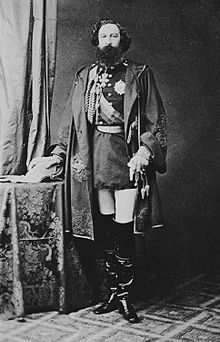
Back Ferrando II de Portugal AN فرديناند الثاني ملك البرتغال Arabic فرديناند التانى ملك البرتجال ARZ ایکینجی فرناندوی AZB Фернанду II Byelorussian Фердинанд II (Португалия) Bulgarian Fernando II Portugal Breton Ferran II de Portugal Catalan Ferdinand II. Portugalský Czech Ferdinand 2. af Portugal Danish
| Ferdinand II | |
|---|---|
 King Ferdinand in 1861 | |
| King of Portugal | |
| Reign | 16 September 1837 – 15 November 1853 |
| Predecessor | Maria II |
| Successor | Pedro V |
| Co-monarch | Maria II |
| Prince consort of Portugal | |
| Tenure | 9 April 1836 – 16 September 1837 |
| Regent of Portugal | |
| Regency | 15 November 1853 – 16 September 1855 |
| Monarch | Pedro V |
| Born | Prinz Ferdinand von Sachsen-Coburg-Saalfeld 29 October 1816 Palais Coburg, Vienna, Austrian Empire |
| Died | 15 December 1885 (aged 69) Necessidades Palace, Lisbon, Portugal |
| Burial | 21 December 1885 Pantheon of the House of Braganza, Lisbon, Portugal |
| Spouses | |
| Issue Detail | Pedro V Luís I Infante João, Duke of Beja Maria Ana, Princess Georg of Saxony Antónia, Princess of Hohenzollern Infante Fernando Infante Augusto, Duke of Coimbra |
| House | Saxe-Coburg and Gotha-Koháry |
| Father | Ferdinand, Prince of Saxe-Coburg and Gotha-Koháry |
| Mother | Princess Maria Antonia Koháry de Csábrág et Szitnya |
| Religion | Roman Catholicism |
| Signature | |
Dom Ferdinand II (Portuguese: Fernando II; 29 October 1816 – 15 December 1885), also known as Ferdinand of Saxe-Coburg and Gotha, was King of Portugal from 16 September 1837 to 15 November 1853 as the husband and co-ruler of Queen Maria II.
In keeping with Portuguese law, Ferdinand only became king after the birth of his first son, Prince Pedro, in 1837. Ferdinand's reign came to an end with the death of his wife in 1853, but he served as regent for his son and successor, King Pedro V, until 1855.
He retained the style and title of king even after the death of Maria II and her succession by their children Pedro V and then Luís I. His sons were reigning kings, while Ferdinand himself was a king-father during their reigns.